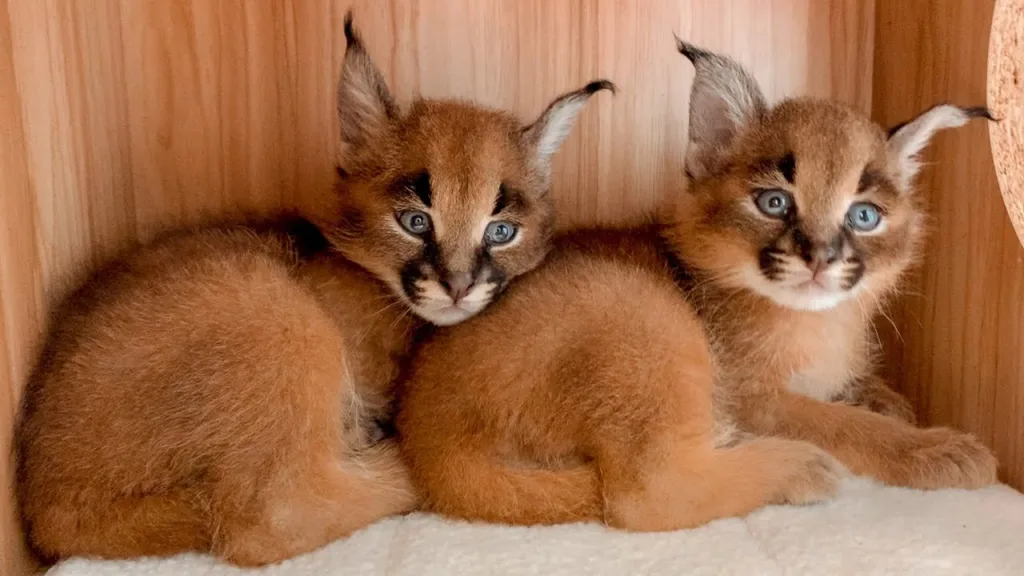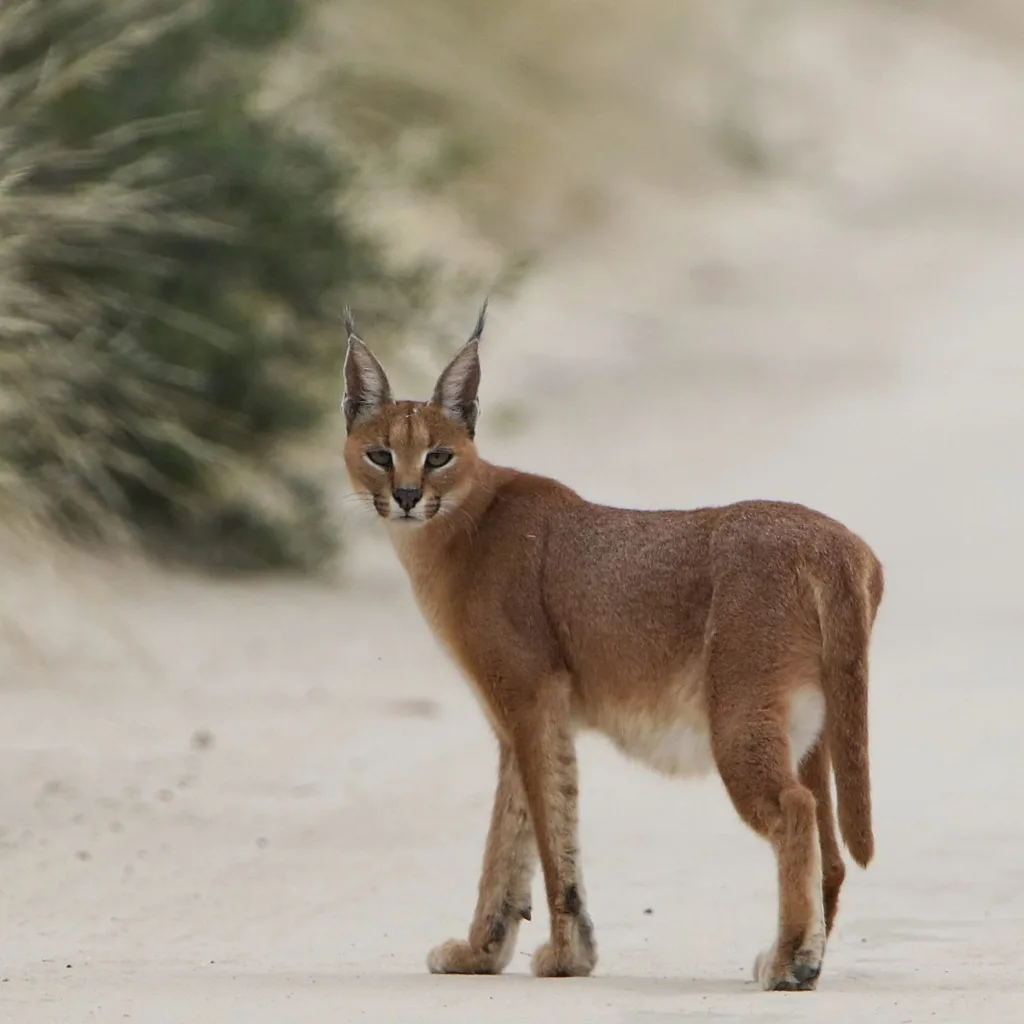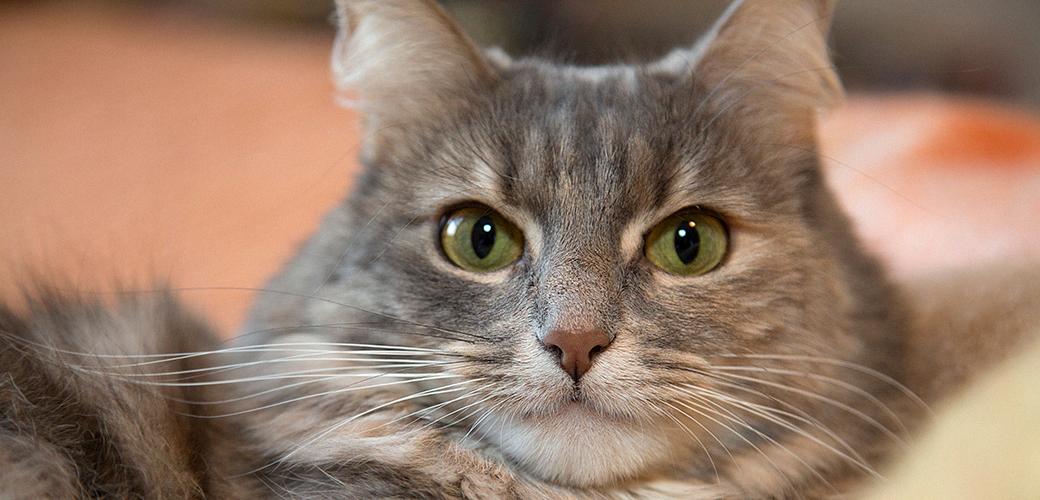Are you looking for an exotic pet to add to your family? Do you want something that’s both rare and beautiful? If so, then a caracal may be the perfect choice for you! Caracals are wild cats found in Africa and the Middle East, and are currently legal to own in 15 U.S. states: Arizona, Arkansas, Delaware, Florida, Indiana, Maine, Mississippi, Missouri, Montana, North Dakota, Oklahoma, Pennsylvania, Texas and South Dakota.
Caracals are medium-sized cats with distinctive tufted ears and long limbs that help them climb trees with ease. They are also exceptionally fast runners – they can reach speeds of up to 48 miles per hour! As pets they tend to be active and playful but can also be very independent.
If you’re cnsidering adding a caracal to your family it’s important to understand that they will require specialized care. For starters they must be kept in an enclosed area such as a large aviary or outdoor fenced enclosure when outdoors as they can easily escape if given the opportunity. Furthermore their diet should consist of raw meat supplemented with vitamin/mineral supplements specially formulated for large cats.
It’s also important to note that caracals can become aggressive when scared or threatened so it’s important for their owners to take necessary precautions such as not leaving children unattended with them or allowing other animals into their enclosure. Additionally caracals have been known to harm small pets such as dogs so it is best to keep them away from other animals unless supervised by an experienced owner.
Finally it’s important to note that purchasing a caracal is quite expensive – prices typically range from $1,500-$20,000 USD – plus the cost of food and veterinary bills over its lifetime can quickly add up. However if you have the resources and commitment necessary owning a caracal could provide years of enjoyment for both you and your new pet!
Are Caracals Legal as Pets?
In certain states in the United States, it is legal for licensed individuals to own pet caracals. This includes Arizona, Arkansas, Delaware, Florida, Indiana, Maine, Mississippi, Missouri, Montana, North Dakota, Oklahoma, Pennsylvania, Texas and South Dakota.
In order to legally own a pet caracal in these states an individual must obtain a license from the local Fish & Wildlife department or othr relevant regulatory body. The licensed individual must also provide suitable and safe housing for the animal and adhere to any additional regulations specific to that state.
It is important to note that owning a pet caracal can be dangerous if proper safety measures are not taken. The animal is wild and may have unpredictable behavior. It is also illegal to capture wild caracals without the appropriate permit and most states prohibit the sale of wild-caught animals as pets.

Source: cnbc.com
Are Caracals a Safe Pet?
No, caracals are not safe. Caracals are wild animals and can be unpredictable and dangerous. They have sharp claws and teeth which they can use to attack when they feel threatened. They are also known to be aggressive to small animals, such as cats or dogs, and can even attack humans if they feel threatened or provoked. Therefore, it is important to keep a safe distance from them at all times, as well as keeping pets away from them. It is best not to approach caracals in the wild or attempt to handle them if encountered in captivity.
The Cost of a Caracal
The cost of a caracal can vary greatly depending on the age, breed, and where it is being purchased. Generally speaking, the initial purchase of a caracal will start at aroud $1,500 USD and go up to as high as $20,000 USD. This price range will cover most standard exotic cats. However, rare breeds or special ages may have higher prices. In addition to the initial purchase price, owners must also factor in food costs for their caracal which can be quite expensive due to its diet of fresh meat and specialized supplements. Ultimately, the cost of owning a caracal should be considered carefully before making such an investment.
Do Caracals Express Happiness Through Hissing?
No, caracals do not hiss when they are happy; instead they may purr to show contentment. When caracals are feeling threatened or aggressive, they may produce a low-pitched hissing sound. Other vocalizations they may make include mews, growls, and yowls.
Are Caracal Cats Prone to Aggression?
Yes, caracal cats are known to be aggressive animals. They are solitary creatures who prefer to hunt alone at night, and they can become extremely territorial when threatened. Caracals are known to stand their ground and even fight off predators that may be larger than them, like lions and hyenas. While they may not attack humans unprovoked, they can become very defensive if they feel threatened. It is best to observe caracals from a distance and not approach them, as they may become aggressive if startled.

Are Caracals Suitable as Pets?
No, caracals are not suitable pets for most households due to their potentially aggressive behavior. Although caracals are generally not known to attack an adult human, there have been cases of them attacking unprovoked and without warning. For this reason, it is best to avoid keeping caracals as pets if your family includes small children or other vulnerable individuals.
Do Caracals Make Hissing Sounds Instead of Meowing?
Yes, caracals hiss instead of meowing like other cats. In addition to their trademark meows and purrs, caracals can also express themselves by growling, hissing, and spitting when they feel threatened or agitated. Hissing is a common behavior for cats of all sizes and breeds, as it is a warning signal that lets them communicate with each other in an aggressive manner.
Do Caracal Cats Meow?
Yes, caracal cats can meow! They make a unique sound that is similar to a meow, but with extra vibrato. This sound is called a trill and has been described as sounding like an “eerie chirrup”. The trill can be heard when the cats are communicating with each other, or when they are trying to get the attention of their owners. Caracal cats also have the ability to purr and growl.
Lifespan of Caracals
Caracals are a species of wild cat native to Africa, the Middle East and Central Asia. On average, they live for 12 years in the wild, but if they are kept as pets in human care they can live up to 17 years. The oldest recorded caracal lived to be 20 years old. In captivity, caracals are provided with special diets, medical attention, and ample room to roam which can contribute to their longer lifespan.

The Reasons Behind Caracal Cats’ Hissing
Caracal cats are known to be very vocal and their hissing is one of the main ways they communicate. Hissing is used as a warning sign to ward off possible dangers or let other animals in the area know that they’re tere and not to be messed with. It can also be used as a form of self-defense, as it can scare away potential predators. Additionally, caracal cats may hiss when feeling threatened or anxious, as a way to assert their dominance and make themselves feel more secure in an uncomfortable situation. Furthermore, hissing can also simply be a sign of excitement, such as when greeting another cat or person for the first time!
Can Caracals and House Cats Mate?
It is technically possible for a caracal and a house cat to mate; however, it is highly unlikely to happen in the wild. This is because caracals are found in Africa, the Middle East, and Central Asia, whereas house cats are found mostly in human dwellings. In addition, caracals are much larger than house cats – up to 40 pounds compared to 8-10 pounds for an average house cat – and this could be dangerous for the smaller House cat. If breeding between the two species is attempted in captivity, it would lkely take several generations before any uniformity of appearance can be achieved in the offspring.
What is a Floppa Cat?
A Floppa cat is a domesticated caracal, which is a wild African lynx species. The term ‘Floppa’ has been adopted as an affectionate nickname by pet owners of caracals on social media, most notably Pumba from Latvia. Caracals are known for their distinctive tufted ears and long legs, and their athleticism which allows them to jump up to 3 meters high! They are also highly intelligent and have been trained to perform tricks such as fetching and even jumping through hoops. Gosha and Pumba, two famous Floppas, famously met virtually in 2022 via Skype!
The Bite Force of a Caracal
The bite force of a caracal is estimated to be around 85.90 Newtons (N). This is based on a study conducted by the Brain Function and Complex Adaptive Systems lab at the University of Arizona, which measured the bite force of four different species of wild cats – Caracal caracal, Leptailurus serval, Leopardus pardalis and Lynx rufus. The caracal had the highest recorded bite force, at an estimated 85.90 N.

Source: aspca.org
The Function of Caracal Ear Flicking
Caracals flick their ears for two main reasons: to detect movement and to attract prey. By flicking their ears, caracals can detect the faintest of movements from prey animals like birds. This helps them to locate and stalk their prey more easily. The second reason is to attract birds, as caracals often sit in tall grasses and flick the tops of their ears to fool birds into thinking they are insects. This causes the birds to come down closer, making them easier targets for a successful hunt.
The Jumping Ability of Caracals
Yes, caracals can jump extremely high. In fact, they are able to jump up to 3 meters in height! They have powerful back legs and special muscle fibers that enable them to generate three times the power of a human athlete, making them incredibly well-adapted for leaping such great heights. Additionally, these traits make them very fast when taking off.
Conclusion
In conclusion, caracals are a wildcat species that can be legally purchased and owned in certain US states. Although they can make a loyal pet, owning a caracal is not to be taken lightly – they are powerful animals that pose a risk to humans and other smaller animals, and can cost thousands of dollars to purchase and maintain. Before considering this type of pet, it’s essential to do extensive research and ensure you have the necessary resources to properly care for one.
